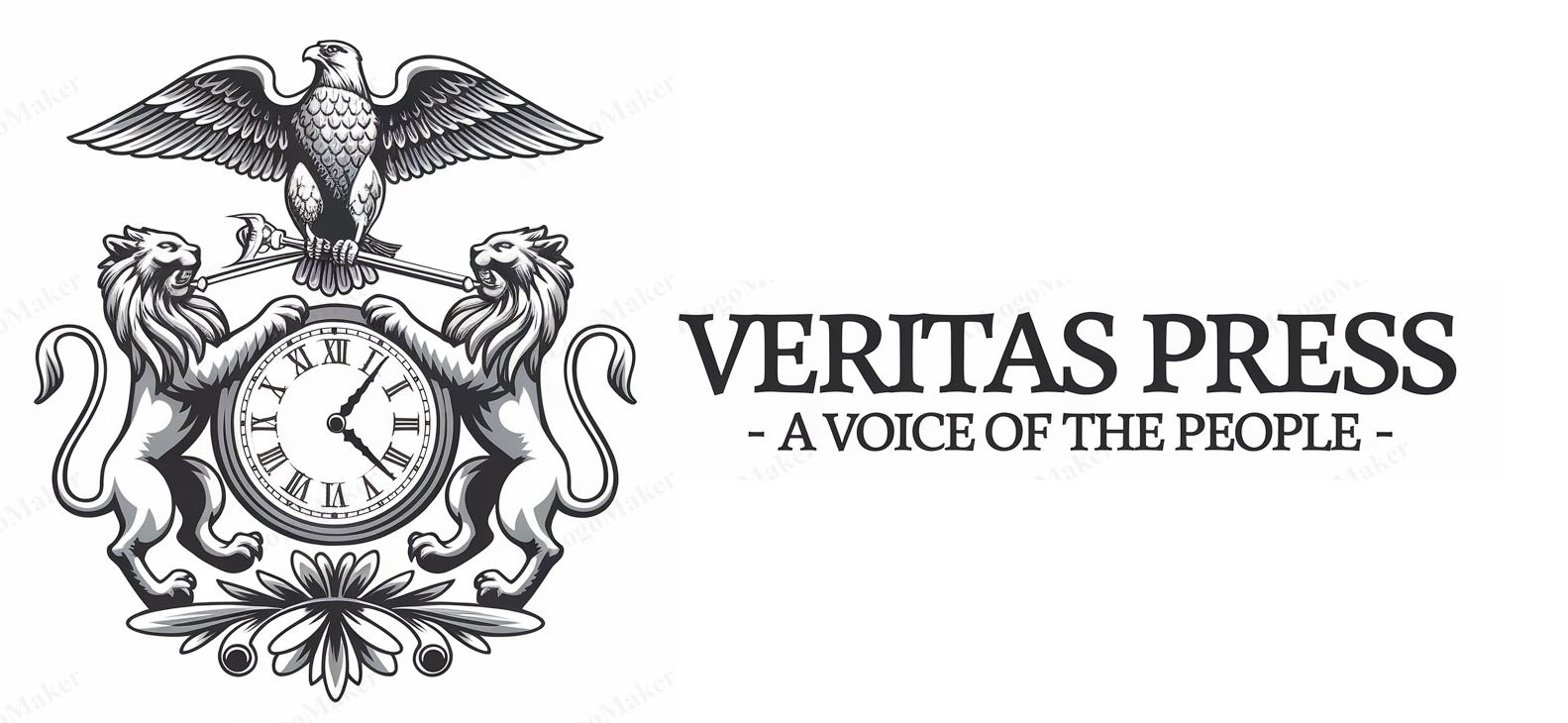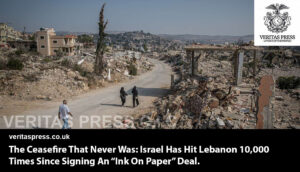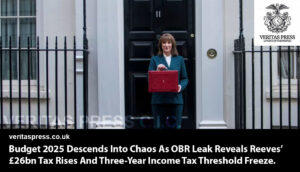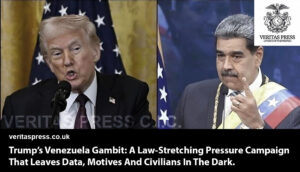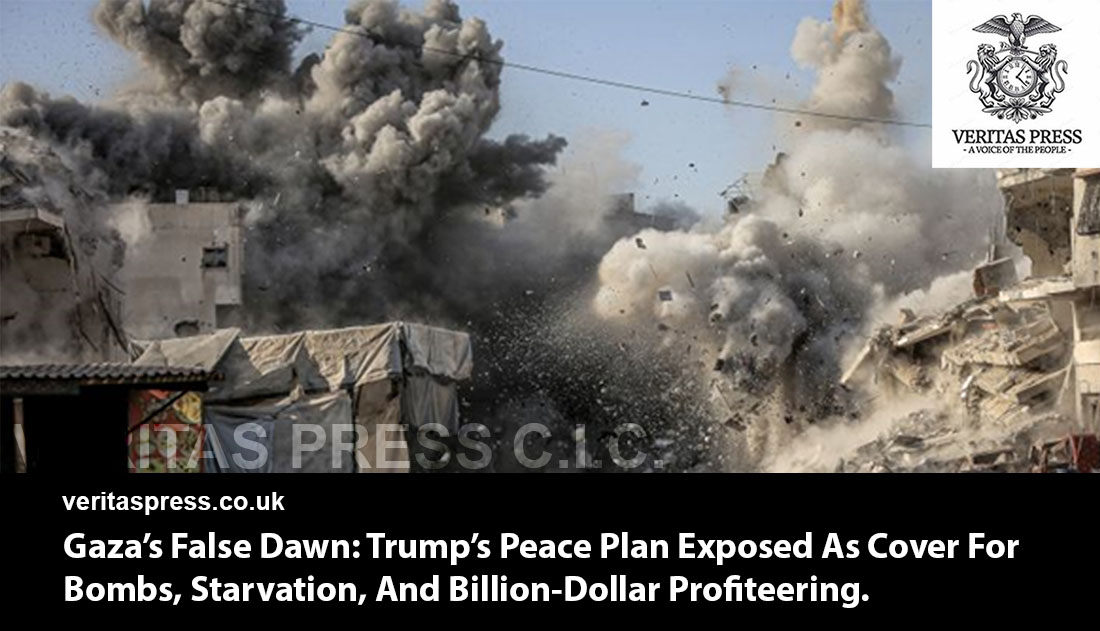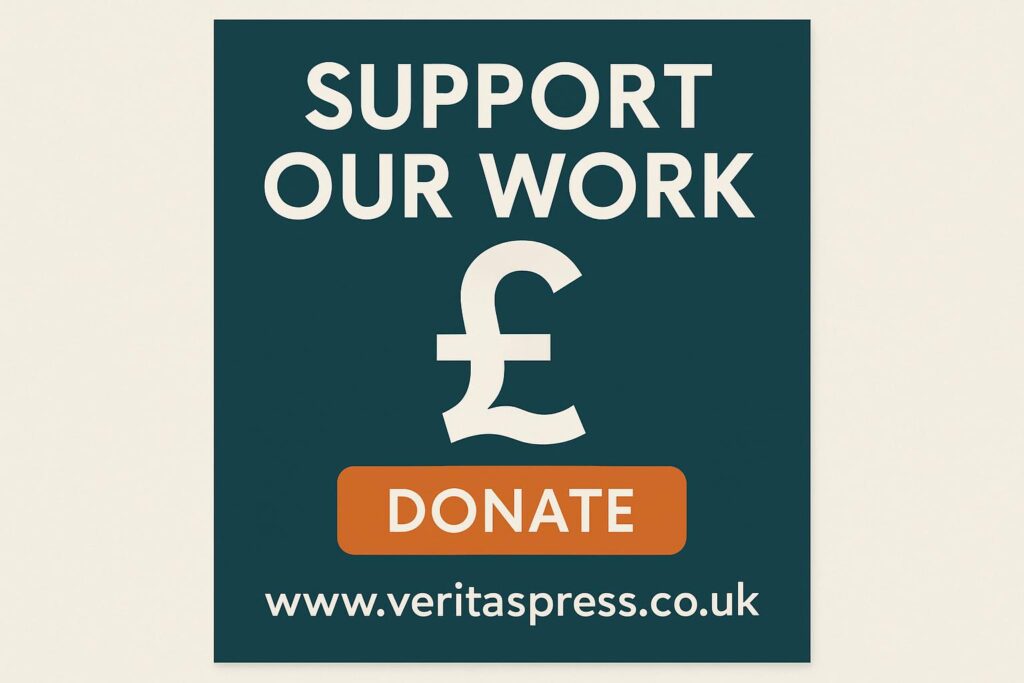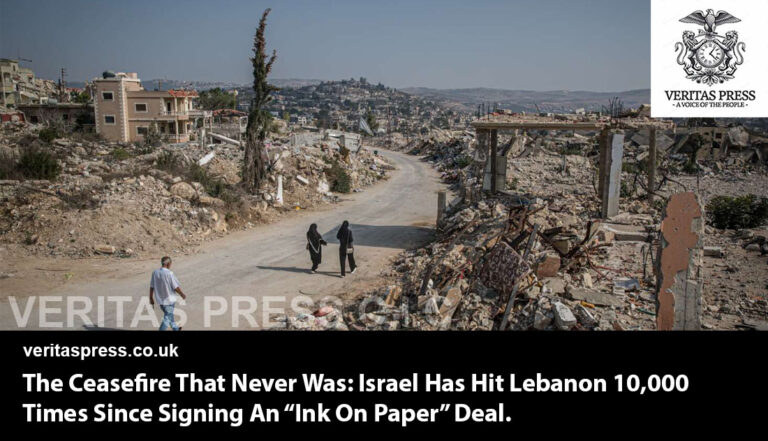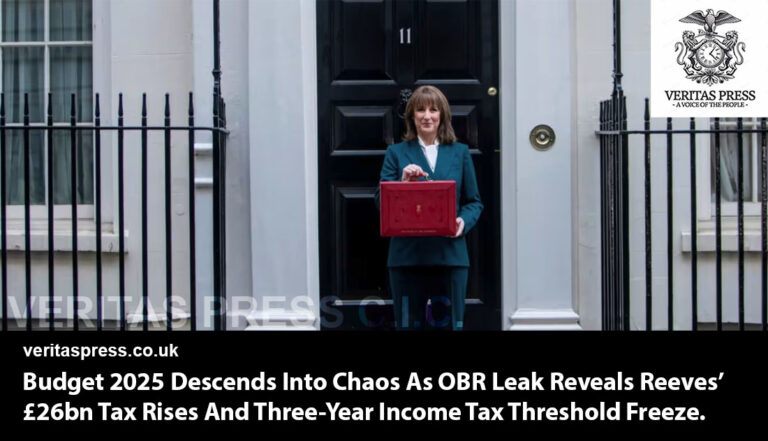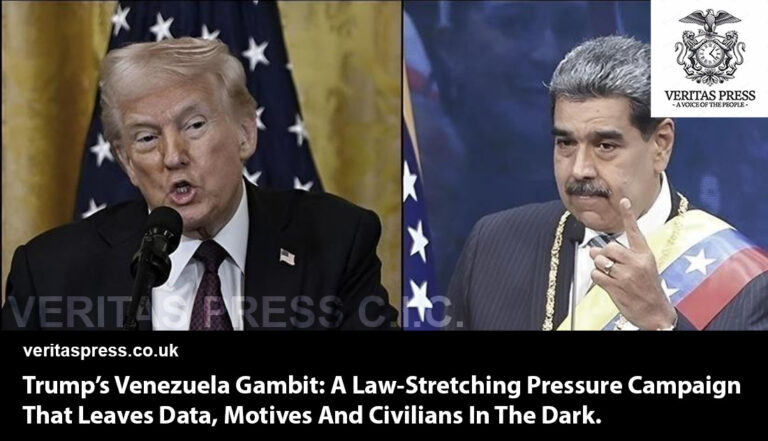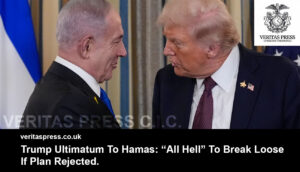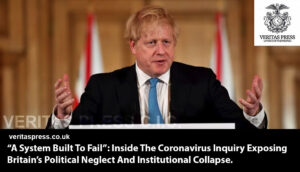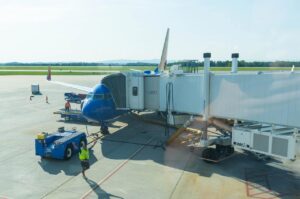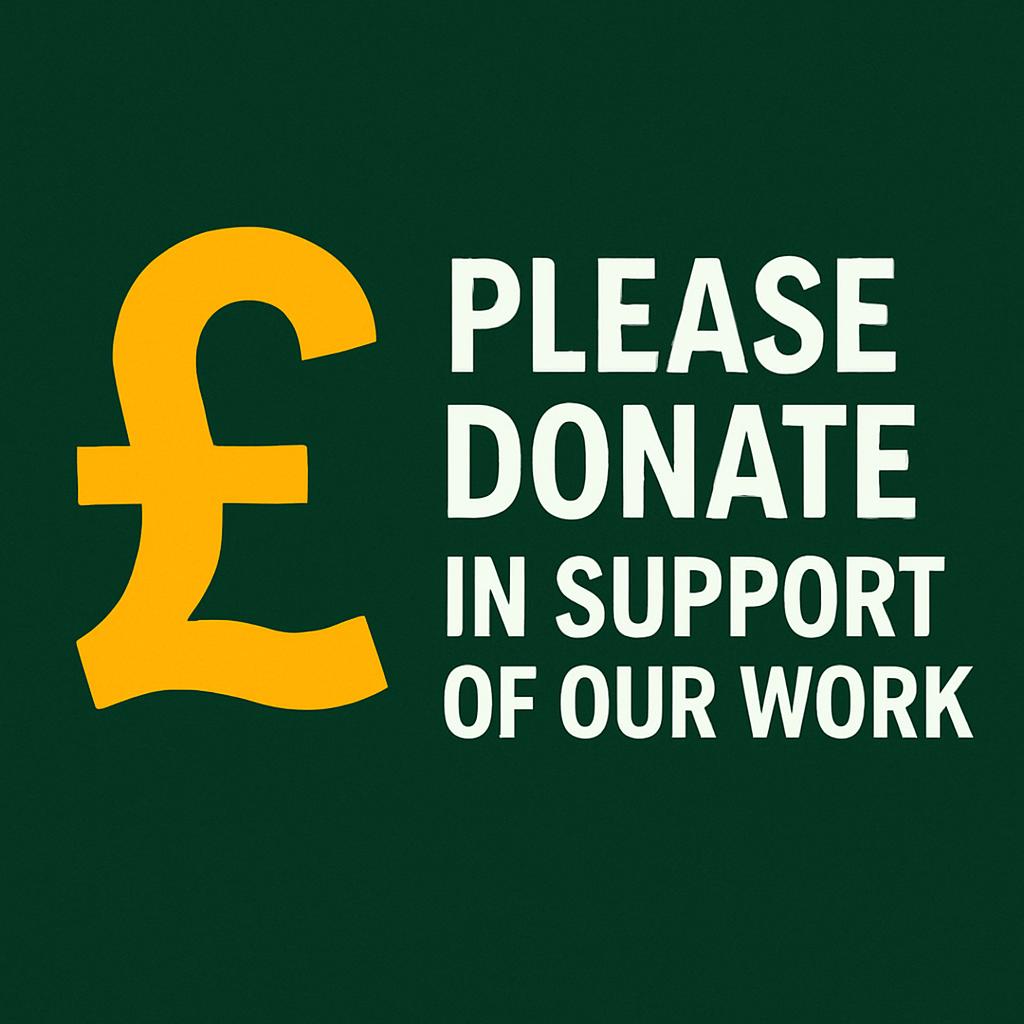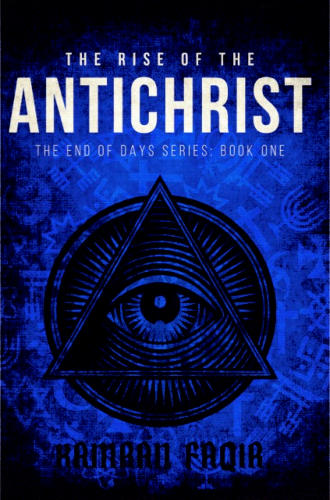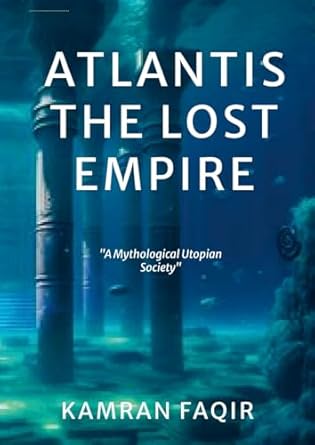GAZA CITY — October 4, 2025, Israel’s war on Gaza shows no sign of slowing, even after Hamas offered concessions that U.S. President Donald Trump hailed as “the foundation for lasting peace.” Instead, within hours of Hamas’s response, Israeli jets pounded Gaza City, Khan Younis, and Al-Bureij camp, killing over 83 Palestinians in one day, including at least six children.
The carnage illustrates the core contradiction of Trump’s 20-21-point “peace plan”: a document marketed as a ceasefire blueprint but in practice designed to lock Gaza into permanent dependency, while corporations, Gulf royals, and Western arms firms prepare to profit from its ruins.
“They talk about reconstruction while they bomb our hospitals,” said Dr. Hanan Abu Salim, a paediatrician at Nasser Hospital, after two children killed in Khan Younis were laid in the morgue. “We don’t need a plan written in Washington. We need the bombing to stop.”
The Leaked UN Legal Review:
A confidential 37-page review by UN legal experts, leaked to Le Monde and obtained by The Intercept, concludes Trump’s Gaza plan violates at least 15 principles of international law, including:
- Collective punishment: tying aid to political compliance.
- Violation of sovereignty: installing a foreign-controlled “Board of Peace” to govern reconstruction.
- Denial of self-determination: excluding Palestinians from core decisions about governance and borders.
- Forcible transfer risk: the plan leaves open “voluntary relocation” of Gazans under foreign management, which experts flagged as “legally indistinguishable from coerced displacement.”
“The plan is not peace; it is a restructured occupation,” said one UN official involved in drafting the review. “International law is clear: Gaza’s people must decide their future, not Wall Street or Tony Blair.”
Corporate Profiteering: Who Stands To Gain.
Documents circulating among Gulf investors, seen by Middle East Eye, detail multi-billion-dollar tenders already being drawn up for Gaza’s “redevelopment.”
- Emaar Properties (UAE) has drafted plans for a luxury “Gaza Waterfront” project, eerily similar to the “Riviera” scheme floated by Trump in 2019.
- Qatari Diar has circulated proposals for rebuilding destroyed neighbourhoods with “mixed-use developments” tied to foreign ownership schemes.
- BlackRock and Goldman Sachs are preparing “Gaza Reconstruction Bonds,” pitched to sovereign wealth funds in the Gulf.
- Halliburton, the U.S. oilfield giant, has reportedly submitted interest in “infrastructure tenders” for rebuilding water and electricity networks.
A senior European diplomat described it bluntly: “Gaza is being turned into an investment zone. The bombs fall, then the contracts rise.”
Blair’s Return: The “Board Of Peace”.
Trump’s plan centres on a “Board of Peace”, a transitional authority chaired by former UK Prime Minister Tony Blair and stacked with Gulf royals, U.S. billionaires, and Israeli-linked security firms.
Blair, who resigned as Middle East Quartet envoy after corruption scandals, has long courted Gulf financiers. Now, under Trump’s plan, his board would control aid distribution, bypassing both Hamas and the Palestinian Authority.
Palestinian factions dismissed the move as “neo-colonial.” As Osama Hamdan, a senior Hamas figure, told Al Araby TV:
“We will never accept foreign governorship of Gaza. Gaza belongs to its people, not Tony Blair or Trump’s billionaires.”
Starvation By Design:
The Gaza Health Ministry confirmed two more child starvation deaths this weekend, pushing 2025’s total above 650. Aid groups say famine is being used as leverage.
Bushra Khalidi of Oxfam accused Israel of “weaponising hunger,” citing systematic denial of flour, baby formula, and medical supplies.
UNICEF’s latest report notes that 1 in 3 children under five in Gaza is acutely malnourished, calling it “a man-made crisis, not a natural disaster.”
Eyewitnesses say Israeli drones deliberately targeted food distribution lines. “People were waiting for bread when the missile hit,” said Ahmed al-Talouli, a survivor from Gaza City. “We pulled burned bodies from the flour sacks.”
The Weapons Pipeline: Shielded By Law.
While Gaza starves, Western arms companies continue to profit.
- Lockheed Martin and Northrop Grumman supply the F-35 jets bombing Gaza, assembled with components from BAE Systems UK.
- Raytheon produces precision-guided bombs used in recent strikes on Khan Younis.
- A ProPublica review of U.S. export filings found that over $1.3 billion in arms sales were approved to Israel since October 2023, even after the International Court of Justice (ICJ) ruled that Israel’s campaign in Gaza posed a “plausible case of genocide.”
How do they get away with it? Loopholes.
- In the U.S., Section 127e of the Foreign Assistance Act exempts Israel from human rights conditionality applied to other allies.
- In the UK, “open general export licenses” allow firms to ship dual-use components without parliamentary approval.
“This is legalised complicity,” said Andrew Feinstein, arms trade expert. “The West has hardwired immunity for its corporations into the law.”
Netanyahu’s Double Game:
Netanyahu is formally “on board” with Trump’s plan but privately reassures far-right partners it won’t be implemented in full. A cabinet leak published by Haaretz quotes Defence Minister Yoav Gallant:
“We cannot allow quiet until Hamas is crushed. Any pause is a gift.”
The far-right bloc is already pushing for permanent Israeli security control. National Security Minister Itamar Ben-Gvir called Trump’s plan “surrender.” Finance Minister Bezalel Smotrich has demanded annexation of “buffer zones” in Gaza.
“Netanyahu is playing both sides, flattering Trump while feeding his extremists,” said Israeli analyst Nahum Barnea. “The result: endless war.”
The Deadly Gap Between Words And Reality:
On Friday, Trump ordered Israel to “stop bombing immediately.” By Saturday morning, Baptist Hospital in Gaza had received four corpses, including children.
“For us, Trump’s words are meaningless,” said Dr. Youssef al-Najjar, surgeon at Baptist. “Every day we count bodies. That is the only reality.”
Annexe I: The UN Legal Review, 15 Breaches Of International Law.
The leaked 37-page internal review by UN legal experts (shared with Le Monde and later obtained by The Intercept) identifies 15 violations of international humanitarian and human rights law in Trump’s Gaza “peace plan.” Among them:
- Collective Punishment (Geneva Conventions, Art. 33): tying aid and reconstruction to political concessions.
- Violation of Sovereignty (UN Charter, Art. 2): foreign-controlled “Board of Peace” overrides Palestinian authority.
- Denial of Self-Determination (ICCPR, Art. 1): Palestinians excluded from decisions on governance, borders, or future status.
- Illegal Occupation Entrenchment (Hague Regulations, 1907): legitimising indefinite Israeli military presence.
- Forcible Transfer (Rome Statute, Art. 7): “voluntary relocation” clauses flagged as a cover for coerced displacement.
- Starvation as a Weapon (Rome Statute, Art. 8): conditional food distribution and foreign-managed rationing.
- Discriminatory Reconstruction Framework (ICERD): different rights for Palestinian vs. foreign/Gulf investors.
- Expropriation Without Consent (Customary IHL): foreign leasing of Palestinian land without the owner’s consent.
- Impunity for War Crimes (UNGA Res. 3070): lack of accountability for civilian killings and destruction of infrastructure.
- Economic Exploitation of Occupied Territory (Fourth Geneva Convention): foreign corporations profiting from occupied lands.
- Violation of Refugee Rights (UNGA Res. 194): no reference to the right of return for displaced Palestinians.
- Suppression of Political Freedoms (ICCPR, Arts. 19 & 21): the plan criminalises Palestinian political activity deemed “obstruction.”
- Disregard for Cultural Property Protections (1954 Hague Convention): no safeguards for mosques, churches, or heritage sites.
- Denial of Humanitarian Access (Customary IHL): aid distribution subject to foreign board approval.
- Creation of a Neo-Colonial Governance Structure (UNGA Res. 1514): trusteeship-like model outlawed in the postcolonial era.
A senior UN lawyer who helped draft the review told Le Monde:
“This is not a peace plan. It is the legal scaffolding for occupation and economic predation dressed in the language of aid.”
Annexe II: The Profiteers’ Network.
Trump’s Gaza plan is less about peace than about creating an investment frontier. Documents reviewed by Middle East Eye and ProPublica reveal a coordinated network of corporations, financiers, and political figures shaping Gaza’s post-war future.
Real Estate & Construction:
- Emaar Properties (UAE) — Drafted a “Gaza Waterfront” project modelled on Dubai’s Palm Islands, promising “exclusive foreign investor access.”
- Qatari Diar — Circulating blueprints for luxury redevelopment of destroyed neighbourhoods, tied to long-term land leases.
- Shikun & Binui (Israel) — Israeli construction giant with U.S. subsidiaries poised to take subcontracting roles, despite accusations of illegal West Bank settlement building.
Finance & Bonds:
- BlackRock & Goldman Sachs — Preparing “Gaza Reconstruction Bonds” for Gulf sovereign funds, modelled on post-war Iraq financing instruments.
- Carlyle Group — Lobbying U.S. Congress for special exemptions to manage foreign direct investment into Gaza projects.
Energy & Infrastructure:
- Halliburton — Submitted preliminary interest in water/electricity tenders, echoing its Iraq War role.
- Siemens (Germany) — Lobbying the EU for contracts on Gaza’s destroyed power grid.
- Chevron — Exploring offshore gas development tied to Gaza’s coast, sidelining Palestinian claims.
Security & Surveillance:
- NSO Group (Israel) — Pitched proposals to the Board of Peace for Gaza-wide biometric registration and surveillance.
- Palantir Technologies (US) — In discussions with Gulf investors about data systems for aid “accountability.”
Political Figures & Lobbyists:
- Tony Blair — Central figure, proposed as Board chair. Blair’s consultancy already works with Saudi and Emirati sovereign wealth funds.
- Jared Kushner — Serving informally as Trump’s envoy to Gulf royals, reviving contacts from his 2020 “Peace to Prosperity” plan.
- Heritage Foundation — Drafting “legal cover” arguments for bypassing Palestinian sovereignty in aid distribution.
A European diplomat described it as “a privatised Marshall Plan without sovereignty, investors reap profits, Palestinians lose control.”
Annexe III: The Weapons–Law Nexus.
The same corporations that level Gaza also stand to profit from its reconstruction.
- Lockheed Martin supplies the F-35s striking Gaza, while BAE Systems UK builds critical components.
- Raytheon manufactures precision bombs, including those that hit Khan Younis.
- These firms are legally shielded by export loopholes: U.S. law exempts Israel from rights conditions, UK law uses “general licenses” to avoid parliamentary oversight.
“War crimes become a revenue stream,” said Andrew Feinstein, author of The Shadow World: Inside the Global Arms Trade. “This is the business model, destruction followed by reconstruction.”
Conclusion: Peace As Theatre, Genocide As Opportunity.
Trump’s 20-21-point “peace” plan reads less like a roadmap to justice than a manual for managed dispossession: a legal and financial architecture designed to convert Gaza’s ruins into an investment playground while insulating the architects of its destruction. The leaked UN legal review lays out the charges in juridical terms; on the ground, the reality is brutally simple. Bombs fall, children die of hunger, and tenders are already drafted by the very corporations poised to profit from rebuilding what they helped dismantle.
“This is the shock doctrine applied to genocide. Destroy a society, then rebuild it on terms dictated by corporations and occupiers,” Naomi Klein told Democracy Now!, and the metaphor here is not hyperbole but method. The sequence is clear: militarise, deplete, then privatise. The Board of Peace, the reconstruction bonds, the Gulf developers and private equity backers are not benevolent saviours; they are the business plan that follows the bombardment.
For Palestinians on the ground, the choice is not between Trump’s plan or Netanyahu’s war. It is between survival and erasure. There is no neutral “post-conflict” market when the conditions of the conflict are themselves manufactured to produce submission. Aid conditionality, foreign-run governance, and demilitarisation prerequisites are not neutral mechanisms of stability; they are instruments that entrench dependency and strip political agency.
“We will not disappear for their contracts,” activist Mariam Abu Daqqa told us in Rafah. “We bury our children today, but tomorrow we fight for our land.” Her words are not rhetoric; they are a promise and a challenge: to the architects of the plan, to the financiers circling the carcass, and to an international community that too often tolerates spectacle over substance.
If the world lets the bombs continue while whitewashing a plan that legal experts call illegal and colonial, then peace becomes a cover for plunder, and atrocity becomes a commercial opportunity. The real test is simple: will global powers, parliaments, and courts hold those responsible, political leaders, arms suppliers, financiers and intermediaries to account? Or will Gaza’s ruins be fenced off, tendered out, and rewritten into yet another case study of profit from pain?
Until the bombing stops, until aid flows unconditioned, and until Palestinians themselves control their future, every treaty, deadline, and boardroom memo will be theatre, and Gaza’s people will pay the price, unfortunately.
“As the bombs keep falling and blueprints for reconstruction circulate in foreign capitals, one question lingers: who will truly decide Gaza’s future, Palestinians, or their occupiers and investors?”
